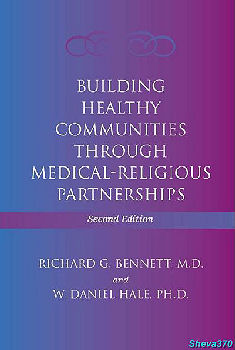
|
Posted November 9, 2010
Book: Building Healthy Communities Through Medical-Religious Partnerships Authors: Richard G. Bennett, M.D., W. Daniel Hale, Ph.D. The John Hopkins University Press. Baltimore, MD. 2009. Pp. 228 An Excerpt from the Foreword:
Recent scientific studies have demonstrated the major role that religion can play in good health outcome. In addition, patients and physicians are recognizing the importance of spiritual resources in the prevention of and recovery from illness. Congregations are seeing an expanding role in health care. A 2007 National Council of Churches survey of 6,000 congregations reported that 70 percent are engaged in health ministry. This favorable response is echoed by the authors’ studies of various denominations. The changing face of illness in the United States, from infectious diseases to more chronic illness plus the graying of our population, means that congregational support and educational programs are a key resource for long-term care needs as well as prevention strategies. The chapters on diabetes, dementia, mental illness, etc. specially illustrate the congregation’s role in addressing these and other illnesses. Providing accurate, clear, and accessible health information is only one step to prevention. Motivating people to act on it is difficult, and congregations can be outstanding partners in that regard. Illustrative and effective programs, some of which have received large grants, encourage others to undertake such ministry, which can help reduce the $2.4 trillion annual expenditures in the United States as well as reduce the number of uninsured Americans, now at almost 46 million. Some churches cannot undertake major programs, so the authors’ suggestion for modest projects — such as training patient advocates and offering respite care programs, screenings, support groups, and informational mailings — enable almost any congregation to become involved in meeting health care needs. One creative program for church members was a “living wills party,” hosted by a registered nurse in her home, which provided information and encouraged people to fill out an advance directive. There is a particular need for destigmatization of mental illness, which affects members of religious communities and their families in about the same proportion — that is, 30 percent — as the general population. . . .In addition to the chapters on disease, there are practical ones on advance directives and communicating with health care providers, a subject that touches many people. The section on lifestyle-related problems, addressed by exercise and diet, tobacco-cessation programs, etc. is brilliant, as all objections are answered with practical suggestions. An Excerpt from the Book: What Can Be Done To Prevent Hypertension And Its Complications? The development of high blood pressure can likely be delayed through a number of lifestyle modifications including weight loss, regular exercise (both aerobic and low intensity), consumption of a diet low in salt and animal fat and rich in vegetables and fruit, and lowered alcohol intake. Studies have not shown that stress reduction programs or use of dietary nutritional supplements (e.g., fisho oil, magnesium, fiber) can effectively prevent development of hypertension. Because high blood pressure is an independent risk factor for the development of cardiovascular disease, prevention programs should also address other lifestyle modifications, including smoking cessation and control of hyperchlesterolemia. Hypertension often goes undetected because it may produce no symptoms unit it seriously damages the heart, brain, or kidneys. Some people with hypertension report headaches, but generally hypertension is discovered through routine checks or medical examinations. Fortunately, the assessment of blood pressure is easy and inexpensive. The major challenge health professions face is persuading people that they should have there blood pressure checked on a regular basis and that they should seek treatment if they are found to have hypertension. Given the increasing numbers of young adults and children with obesity, assessment of blood pressure should be done even for younger individuals on a regular basis. The good news about hypertension is that the intervention that can be used to prevent it also treat it. Once diagnosed, lifestyle modifications are frequently effective in controlling blood pressure. These include weight loss, restriction of salt intake, and exercise. Reduced alcohol consumption and potassium supplementation may also be useful interventions. Lifestyle modifications are generally recommended as an initial method of controlling blood pressure, but if such modifications are insufficient to bring blood pressure under control, numerous medications are available. Often more than one medication is required, and achieving successful control can take a number of weeks or months and multiple visits to the doctor. . . .Studies have shown that as many as half of patients who begin treatment for hypertension fail to continue. Suggestions for Congregational Programs Offer periodic blood pressure checks immediately before or after worship services. Give information about locations in the community where members can have their blood pressure checked. Sponsor a special program on hypertension with a physician or nurse educator as your featured speaker. Sponsor a special program on hypertension medications with a pharmacist. Use congregational bulletins and mailings to provide members with basic information on hypertension. Encourage people interested in controlling hypertension to participate in exercise and nutrition programs. Table of Contents: 1. Healing body, mind, and soul — a model for health ministry 2. Addressing challenges through medical-religious partnerships 3. Congregational health education programs 4. Coronary heart disease 5. Hypertension 6. Cancer 7. Diabetes mellitus 8. Depression 9 dementia 10. Influenza and pneumonia 11. Advance directives Advance Directives 12. Communicating with health care providers 13. Modifying common risk factors 14. Managing medications 15. Accidents and falls Resources 16. Community resources 17. Innovative medical-religious partnerships 18. National organizations and resources Appendixes Congregational survey Program evaluation form Patient check sheet Patient information sheet Summary form for physician visit Medication record References Suggested readings |
|
